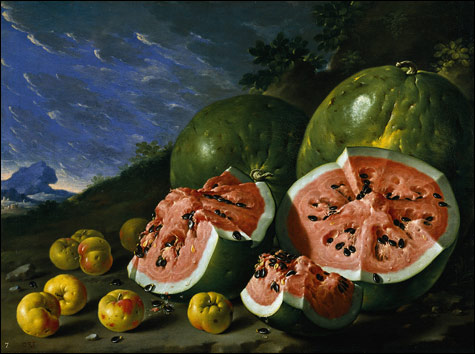
STILL LIFE WITH WATERMELONS AND APPLES IN A LANDSCAPE: These paintings invite you in, whetting your desire, tempting you. |
Luis Meléndez himself greets you at the outset of "Luis Meléndez: Master of the Spanish Still Life" at the Museum of Fine Arts. He seems a haughty 31-year-old in this 1746 self-portrait, standing in a fine silk coat and ruffled shirt and holding up a chalk drawing (note the chalk in his hand) of a hunky nude dude.Luis's father, Francisco Meléndez, was a miniature painter for Spanish kings and also one of the founders of the fledgling Royal Academy of Art in Madrid, where by 1746 Luis was studying. Luis himself had assisted with his father's painting projects, and he spent six years helping in the studio of a royal portraitist. The drawing in his self-portrait signals his desire to rise to the upper echelon of painters and fill canvases and murals with grand Biblical and historical scenes.
But he struggled to obtain regular royal commissions. Four times he petitioned King Charles III for a steady gig, and each time he was rejected. It may not have helped that his father was feuding with his art-school colleagues; Francisco was thrown out the same day that Luis got into a dispute in school and was expelled. After studies in Italy, Luis returned to Madrid, and for five years, he helped his father paint elaborately illuminated pages for a royal-chapel choirbook. But he couldn't seem to win the king's favor on his own.
So in middle age, he began to paint still lifes filled with ripe pears, fresh fish, and crusty bread. The curators of "Master of the Spanish Still Life," which was organized by the National Gallery of Art in Washington, DC, declare him "18th-century Spain's greatest painter of still lifes," though in the catalogue they also acknowledge that, well, he "was the only Spanish painter of his generation to develop in this field," and that "the relative dearth of still-life painters in Madrid in his lifetime suggests there was little contemporary demand." Painting still lifes may have been a blow to his ego (still-life painters, like miniaturists, ranked below painters of Biblical or historic scenes in the Spanish art hierarchy) and his pocketbook, but today it's what makes him stand out from the crowd.
And the 30 still lifes here — about a third of what survives — are splendid. They date from the mid 1760s to the mid 1770s, when he was in his 50s. You can get a sense of why they're so special from that self-portrait. The drawing of the male nude looks as if it were pressed against the picture plane — it's so close, so real, you could touch it. That tantalizing effect is even more palpable in his vividly rendered foods. Each canvas is like a glimpse into the kitchen window of a terrific café. You'll leave feeling hungry.